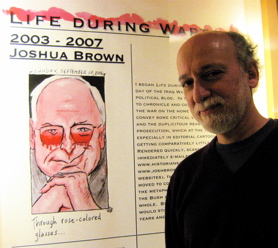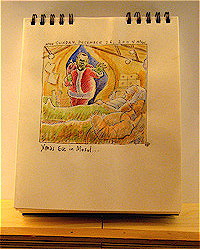Straight Up |: January 2008 Archives
 The puppet master looks like your friendly uncle with a Cheshire cat grin and rose-colored glasses that drip with what? ... strawberry soda? ... cherry syrup? ... Aw gee, have a closer look, it's blood.
The puppet master looks like your friendly uncle with a Cheshire cat grin and rose-colored glasses that drip with what? ... strawberry soda? ... cherry syrup? ... Aw gee, have a closer look, it's blood.
Artist Joshua Brown, who drew the caricature as a diary entry for his visual political blog Life During Wartime, says that before the invasion of Iraq he was fooled into believing "it was going to be a short, ugly, bloody war and that American influence in the Middle East was going to be triumphant."
![Diary entry for Sept. 13, 2007 [After 'An Available Candidate' an editorial cartoon about Andrew Jackson, circa 1848] (Click to enlarge)](http://www.artsjournal.com/herman/petraeus%20180.jpg) It's a telling admission, because Brown's main occupation is teaching radical social history. (He is a grad school professor with a long list of scholarly works to his credit.) But candor is typical of him and worth keeping in mind when looking at the exhibition of all 270 diary entries now on view at The Graduate Center, CUNY, in Manhattan.
It's a telling admission, because Brown's main occupation is teaching radical social history. (He is a grad school professor with a long list of scholarly works to his credit.) But candor is typical of him and worth keeping in mind when looking at the exhibition of all 270 diary entries now on view at The Graduate Center, CUNY, in Manhattan.
Brown trained as an artist before getting his Ph.D. in working-class history at Columbia. (Two murals he painted in 1979 for Yoko Ono and John Lennon apparently still decorate her apartment in the Dakota.) These days he heads the American Social History Project/Center for Media and Learning based at the Grad Center.
Brown began doing his visual blog on the first day of the Iraq war. In a statement for the Life During Wartime exhibition, he writes:
In the beginning I intended to chronicle and comment on the impact of the war on the home front -- and also to convey some critical views about the war and the duplicitous reasons for its prosecution, which at the time, and especially in editorial cartoons, were getting comparatively little public access.
Starting with a rush, he posted a diary entry "every two or three days," Brown says. He then settled down to posting them once a week. "It was the first time I had done art regularly in 30 years," he adds. "I'm not happy with every one by a long shot, but I don't feel lost." Politically, however, he still feels "pissed off, frustrated and ineffective. I must say it doesn't feel cathartic."

A new, huge database created for the first time and posted online by the Center for Public Integrity collects the BananaRepublican lies that took us to war in Iraq. One section highlights Key False Statements.
Researchers Charles Lewis and Mark Reading-Smith write:
President George W. Bush and seven of his administration's top officials, including Vice President Dick Cheney, National Security Adviser Condoleezza Rice, and Defense Secretary Donald Rumsfeld, made at least 935 false statements in the two years following September 11, 2001, about the national security threat posed by Saddam Hussein's Iraq. Nearly five years after the U.S. invasion of Iraq, an exhaustive examination of the record shows that the statements were part of an orchestrated campaign that effectively galvanized public opinion and, in the process, led the nation to war under decidedly false pretenses.
!['Torturer? Moi?' © by Joshua Brown [from Life During Wartime, Dec. 7, 2005]' CLICK TO ENLARGE](http://www.joshbrownnyc.com/images/ldw164.jpg) The center describes itself as "a nonprofit, nonpartisan, non-advocacy, independent journalism organization" designed "to produce original investigative journalism about significant public issues to make institutional power more transparent and accountable."
The center describes itself as "a nonprofit, nonpartisan, non-advocacy, independent journalism organization" designed "to produce original investigative journalism about significant public issues to make institutional power more transparent and accountable."
The New York Times reports this morning in its news story on the database: "There is no startling new information in the archive, because all the documents have been published previously. But the new computer tool is remarkable for its scope, and its replay of the crescendo of statements that led to the war."
That is true. But the old info is plenty startling, doncha think? I'd bet Joshua Brown thinks so. Consider his diary entry for Dec. 7, 2005, above, from his blog Life During Wartime. It's two years old, sure, but as startling as ever. And the words -- pace, Miss Piggy -- are pure Condi. Even if they don't turn up in the database quoted precisely that way.
(Not incidentally, an exhibition of four years of Brown's diary entries, from 2003 to 2007, is on view through Feb. 29 at The Graduate Center, CUNY, where he teaches history and directs the American Social History Project/Center for Media and Learning. More on that later.)
The epigraph on "NO!art MAN," a major 2001 documentary about Boris Lurie, who died earlier this month, says it all: "In a time of wars and extermination, aesthetic exercises and decorative patterns are not enough." Those are Lurie's words, and now they might as well serve as his epitaph.
![NYT obit [NYT, Jan. 12, 2008] (Click to read)](http://www.artsjournal.com/herman/BorisLurieObit%20200.jpg) The obit by Colin Moynihan in The New York Times was an excellent if brief summary of the artist's life and historical significance. But it only skimmed the surface.
The obit by Colin Moynihan in The New York Times was an excellent if brief summary of the artist's life and historical significance. But it only skimmed the surface.
For a deeper appreciation of Lurie's prolific output, as well as his importance, you have to go to the comprehensive Web site NO!art created and maintained by Dietmar Kirves. It is revelatory. There you will find more than 100 images of Lurie's paintings, assemblages, collages, multiples, etchings, posters, sculptures and mixed media works, along with detailed biographical notes, extensive interviews, a filmography of documentaries about him, and critiques, press reports and essays that appeared over the years.
![RAILROAD COLLAGE, 1959 [mixed media on canvas, 46 x 69 cm] (Click to enlarge)](http://www.no-art.info/lurie/works/various/images/1959_railroad.jpg) Although I've known about Lurie since 1973, when I published one of his essays in a Something Else Press anthology (long after he launched the downtown NO!art movement with Sam Goodman and Stanley Fisher), my interest was reignited by Clayton Patterson, when he included Lurie in a group show, "326 Years of Hip," at his gallery on Manhattan's Lower East Side in 2005. (I've posted other items about Lurie -- "Boris Lurie's 'NO!art' and the Holocaust," "Shoah and Pin-Ups" and "Boris on the Bill" -- but it would be an exaggeraton to say they even barely scratch the surface.)
Although I've known about Lurie since 1973, when I published one of his essays in a Something Else Press anthology (long after he launched the downtown NO!art movement with Sam Goodman and Stanley Fisher), my interest was reignited by Clayton Patterson, when he included Lurie in a group show, "326 Years of Hip," at his gallery on Manhattan's Lower East Side in 2005. (I've posted other items about Lurie -- "Boris Lurie's 'NO!art' and the Holocaust," "Shoah and Pin-Ups" and "Boris on the Bill" -- but it would be an exaggeraton to say they even barely scratch the surface.)
It is obvious from the 1959 "Railroad Collage," above, that the Holocaust dominates Lurie's art. How could it not? He was a survivor.
Lurie clearly had the skills to fit any aesthetic mold if he chose. Have a look at the painterly, figurative craftsmanship in his "Dismembered Woman" series: "Figure and Bathtub," or "Apple Eater," or "Nude stepping," or "Pinup with Flower," below.
![PINUP WITH FLOWER [1959, painting, 80 x 130 cm] (Click to enlarge)](http://www.no-art.info/lurie/works/dismembered/images/1959_flower.jpg) But if the Holocaust dominates Lurie's work and is the substrate of the NO!art movement as a whole, other matters were addressed as well.
But if the Holocaust dominates Lurie's work and is the substrate of the NO!art movement as a whole, other matters were addressed as well.
The Israeli filmmaker Amikam Goldman, who made "NO!art MAN," quotes art critic Sarah Schmerler on the "principle aim of NO!art ... to bring back into art the subjects of real life. It thus stood in opposition to the two most popular movements of the era, abstract expressionism and pop art."
"Lurie's art has the distinction of knowing about both freedom and imprisonment, and it is no wonder his work differed from that of the same generation on these shores," Schmerler wrote in a catalog for the "Bleed Show, 1969," a retrospective exhibit mounted in 1997 at the Janos Gat Gallery in New York. "Most American artists of the '40s were fresh out of art school. Lurie was fresh out of Buchenwald."
Not surprisingly, Lurie was unwilling to curry favor with the dealers, collectors and curators whose tastes were offended by the vulgarity he prized in his work. "The art market is nothing but a racket," he said. "There is an established pyramid. ... Everybody who wants to benefit from it has to participate -- if he is permitted to participate."
Nor should it come as a surprise that unstinting efforts to spread the word about Lurie's work, by Kirves, Patterson and others, have largely proved frustrating, especially in the United States, even though Lurie spent most of his adult life after World War II in New York.
Although the Times obit says "his work is included in permanent collections at the Museum of Modern Art in New York and the National Gallery of Art in Washington," Matthias Reichelt, a German critic, curator and editor, begs to differ. "It might be possible that the one or the other collection holds a small print or etching," he says, "but his art is NOT at all part of the permanent collections, neither in Manhattan nor in Washington. It still has to be discovered by the museums for the U.S. public."
This 1959 mixed media painting on canvas, "Lumumba is dead," for example:
![LUMUMBA IS DEAD [1959, mixed media on canvas, 182 x 198 cm]](http://www.no-art.info/lurie/works/various/images/1959_lumumba.jpg)
Reichelt adds:
Boris Lurie was consciously ignored in the 1960s and '70s and the following decades because of the work's content. The museums did not take care of his art at all. They kept him out while other colleagues of his -- like Allan D'arcangelo, Allan Kaprow and Yaoyi Kusama, among others -- made it into the museums.Besides Clayton Patterson and the gallery owner Gertrude Stein, only a few curators and art historians, like Norman Kleeblatt from the Jewish Museum and the freelance art historian and curator Estera Milman, who organized the two major shows in the U.S. in public institutions -- the University of Iowa, in 1997, and Northwestern University's Block Museum in Chicago, in 2001 -- know about Lurie and his radical art.
Patterson, who is a ubiquitous figure on the Lower East Side -- and an artist, photographer, documentary videographer, editor and archivist, not to mention social critic, neighborhood preservationist and rebel in his own right -- has gotten used to the frustration. He still believes recognition will come. "It has to," he says. "It's much too important not to."
![MORT AUX JUIFS [1970, oil on canvas, 233 x 324 cm] (Click to enlarge)](http://www.no-art.info/lurie/works/various/images/1970_mort.jpg)
Just because the NYT editorial "Unfinished Debate on Iraq" popped up today, lamenting the fact that "the war has receded as a major topic on the campaign trail," it does not mean Straight Up is being channelled. Yes, I know, these two questions appeared here on Friday. But so what? Ditto for the Noah Feldman article "Vanishing Act" in today's NYT magazine.
Postscript: Aw ... here's a leetle zumzeeng CNN put on its cover this afternoon, Analysis: Whatever happened to the war?
Does it matter to the pols running for prez? Does it matter to the people voting for the pols? Let's see whether the latest estimate of the civilian death toll in Iraq makes the agenda.
Doubtful. Why should it? It's old news. It's all about the first three years of the war. We're well past that. We're going on ... what? ... five years?
Besides, the number of the dead -- 151,000 between 2003 and 2006, according to the World Health Organization -- doesn't even come close to the 655,000 estimated earlier by researchers from Johns Hopkins.
Yes, the numbers are all over the lot, depending on the source and methodology. Here's a count of documented deaths based on actual reports, not on estimates. As of today, it's only 80,419 to 87,834. Ahhh ... whatever.
The flag-waving has begun, if it ever stopped:
After so many years of fear and loathing, we had almost forgotten what it's like to feel good about our country. On Thursday night, that long-dormant emotion came rushing back, like an old dream that pops out of the deepest recesses of memory, suddenly as clear as light. "They said this day would never come," said Barack Obama, and yet here, right before us, was indisputable evidence that it had.
!['Untitled,' collage by Norman O. Mustill [2007]](http://www.artsjournal.com/herman/UntitledMustillCollage%20%28240%29.jpg) That's the red-white-and-blue lede in Frank Rich's column this morning, as though Obamarama-cum-Huckababy could flush the BananaRepublic down the drain with, he adds, a "palpable sense that our history was turning a page whether or not Mr. Obama or his doppelgänger in improbability, Mike Huckabee, end up in the White House."
That's the red-white-and-blue lede in Frank Rich's column this morning, as though Obamarama-cum-Huckababy could flush the BananaRepublic down the drain with, he adds, a "palpable sense that our history was turning a page whether or not Mr. Obama or his doppelgänger in improbability, Mike Huckabee, end up in the White House."
Please, Frank. Cut the bullshit. The winds of change don't smell all that good. Just read what George McGovern says this morning about impeaching the Bullshitter-in-Chief and Attack Dog, the chief's partner in high crimes and misdemeanors. Or have a look at Norman O. Mustill's collage, above. Maybe it will pop the nightmare instead of the dream "out of the deepest recesses of memory."
For all your shiny prose, dear Frank, and all your anti-establishment chest-thumping about the willful Beltway stupidity of mainstream political journalism -- as though a polished reference to "fear and loathing" could channel Hunter S. Thompson -- your column sounds a helluva lot like that old-time religion.
The hungover staff realizes it cited the supreme lowlight of 2007 here, but none of the highlights. So what the hell, in reply to popular demand, a random sample: Best Yummy, Best Dummy, Best Bulletin, Best Nader, Best Collage, three Best Oldies (X), (Y) and (Z), Best Rupe, Next Best Rupe, Best Ghost, Best Bones, Best Beast and Best Pinocchio.
Sites to See
AJ Blogs
AJBlogCentral | rssculture
Terry Teachout on the arts in New York City
Andrew Taylor on the business of arts & culture
rock culture approximately
Rebuilding Gulf Culture after Katrina
Douglas McLennan's blog
Art from the American Outback
John Rockwell on the arts
Jan Herman - arts, media & culture with 'tude
dance
Apollinaire Scherr talks about dance
Tobi Tobias on dance et al...
media
Jeff Weinstein's Cultural Mixology
Martha Bayles on Film...
music
Greg Sandow performs a book-in-progress
Howard Mandel's freelance Urban Improvisation
Focus on New Orleans. Jazz and Other Sounds
Exploring Orchestras w/ Henry Fogel
Kyle Gann on music after the fact
Doug Ramsey on Jazz and other matters...
Greg Sandow on the future of Classical Music
Norman Lebrecht on Shifting Sound Worlds
publishing
Jerome Weeks on Books
Scott McLemee on books, ideas & trash-culture ephemera
theatre
Elizabeth Zimmer on time-based art forms
visual
Public Art, Public Space
John Perreault's art diary
Lee Rosenbaum's Cultural Commentary
Tyler Green's modern & contemporary art blog

